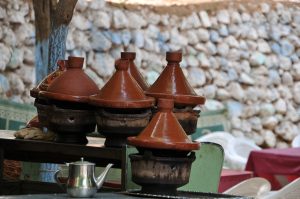Morocco food
During our time in Morocco, we sampled a variety of Morocco food. We linked Arab cuisine with intriguing flavors, blends of oriental spices with meat and vegetables, fragrant variations of tea, and delectable seafood before visiting Morocco. So, what did we get, and what dishes and drinks are served in Moroccan cafés and restaurants? Read this article to learn more about Morocco food.
Couscous with vegetables and meat
Couscous is not cheap in Europe and is nearly regarded an exotic side dish. In the Czech Republic, for example, a kilo of couscous will cost 3-4 euros for gastronomic delights. Couscous is a popular side dish in Morocco and is used to make a variety of traditional recipes. Couscous is a coarsely ground grits, for those who don’t know.
One of the most well-known variants of this side dish Couscous with vegetables and a piece of meat (chicken, beef, or lamb) or fish is typical Morocco food. Couscous is prepared in a pot or a special pot known as a tajine. Tajin is a conical-topped ceramic dish. When food is cooked in a tagine, it stews and develops a subtle flavor. When served, the cover is removed and a ceramic platter with meat on the bone, couscous, coarsely chopped vegetables (turnips, carrots, eggplant), and aromatic spices is placed on top. Doesn’t it sound delicious? However, if you dislike couscous, eat meat, and want to be well-fed, it is absolutely not beneficial for you. This is due to the fact that such recipes include only 100 grams of meat.
In Moroccan restaurants, the average price of veggie couscous with meat (couscous aux legumes et à la viande) is 45-80 Dirhams, depending on how touristy the location where you eat it is. Personally, I expected large quantities at such low pricing in Africa.
Tagine
A tajine is not simply a pot used for stewing meat, but also any food made in one. In a tajine, several varieties of meat or fish meals are produced – we liked the tajine with beef and prunes (tajine de boeuf aux prunes) as well as the tajine with chicken, lemon, and olives (tajine de poulet au citron). Tajine is traditionally cooked over a fire, with spices, dried fruits, and olive oil added to flavor the dish. This meal is topped with nuts or slices of boiled egg and served with slices of Moroccan flatbread to collect the remaining sauce.
Most Moroccan restaurants only have menus in Arabic or French. If you don’t speak any of these languages, make sure to look up the translation of unusual foods in a dictionary, or you might end up ordering tajine with giblets or liver instead of meat.
A tagine’s average price ranges from Dh40 to Dh90, depending on the fillings. We enjoyed the most wonderful and filling tajine for 85 dirhams at Menara Mall in Marrakech. No matter where we tried the tajine, we never had such a strong flavor again. We got the worst tajine with liver in Casablanca at the Zayna restaurant in the new medina.
Kebab Shish Kebab
A popular form of kebab in Turkey, similar to our shish kebab, has made its way to Morocco. Typically, such kebabs are made from chicken or lamb, with fresh veggies and onions added on the skewer. Shish kebab is a quick and easy snack. It is available at roadside cafés and shopping center food courts. It is frequently served with French fries and a small veggie salad on the side. In a clean environment, a portion of shish kebab costs 60-70 dirhams with a side dish.
Soup Harira
Harira is a Moroccan soup made with meat broth, tomatoes, lentils, and chickpeas. The soup is accompanied with a mint flatbread and two dates. The soup can be served with either ground or whole ingredients blended in a blender. When serving, the soup is topped with lemon juice and occasionally with chunks of chicken or lamb. Harira soup seemed extremely oily and spicy to us, which is why Arabs fast with it throughout Ramadan. A bowl of harira soup costs around 6-8 dirhams.
Morocco food mint tea
Local mint tea (thé à la menthe) is often referred to as “Moroccan whisky” since it is so calming. Green tea with peppermint is liberally sugared before being poured into a classic teapot with a narrow spout. The tea is poured from a height into little glass cups, where it is oxygenated and foam forms. Throughout the meal, each person consumes one tiny kettle of mint tea. A cup of mint tea costs 15-20 dirhams in the cafe.
You may buy dried mint in Moroccan shops (for less than 10 dirhams for a huge bundle) and brew yourself a delicious mint tea at home. Another issue is that the tea will not be in factory packaging, which may raise suspicions among customs agents at the border. But, of course, this is a joke. Berber tea, an intoxicating blend of mountain herbs with a distinct flavor, is available in addition to dried mint.
Morocco food desserts
Because the residents love sweets, businesses have entire departments dedicated to small packaged cookies. You can either buy an already prepared box of sweets or make your own. I recall these sweets having a strong almond and honey flavor and a marzipan filling. We brought them to Prague, but when we got there, we found that we just enjoyed them in Morocco, and they didn’t elicit any unique feelings in us. A box containing a kilo of Moroccan sweets costs between 70 and 100 Dirhams. Not a bad gift for sweet-toothed pals.
We sampled these sweets before the Carrefour supermarket in the cute L’Adresse café in Marrakech’s medina’s Djema el-Fna plaza, ordering a dish with them for dessert. It was somewhere about 70 dirhams.
We were really satisfied with the sweets sold by the Paul’s confectionary chain in Morocco. They were far superior to what we were used to in Prague. In Marrakech, a lovely tartlet with raspberries and a cup of coffee costs 55 dirhams.
Fresh Orange with Pomegranate
Morocco has long been known as an orange paradise. Oranges are great here, as is their freshly squeezed juice. We didn’t taste the fresh fruit on the street because the sanitation in some places was terrible, but you can order a fresh fruit composed of luscious oranges for 15-20 dirhams in any café or restaurant. We requested that no ice be added to the juice because flowing water in Morocco is of poor quality, and ice is created from it.
In addition to orange juice, Moroccan streets sell pomegranate juice for only 10 dirhams. By the way, we didn’t care for the local pomegranates, which were little and pink. But the imported Turkish pomegranates, which were literally bursting with juice, were so good that we brought a couple back to Prague with us.
The peculiar thing is that there are carts of cacti here and there in Moroccan medina markets. The merchant uses special gloves to clean the cactus in front of you and pulls out a luscious crimson fruit. The key goal here is to avoid becoming dirty.
Moroccan Fast Food
In Morocco, fast food or street food came in handy, especially near the conclusion of our trip, when the traditional tagine was no longer an option. The fast food options are traditional: pizza, pasta, and burgers. We tasted pizza and spaghetti with meat at the food court at Fez’s mall and were not satisfied, so we ordered more. The pasta was amusing: despite eating two plates, we were still hungry.
We ate really good and juicy burgers at Blend, which was not far from our rented flat in Casablanca. A nice burger with meat at McDonald’s costs roughly 40-50 dirhams. A nice lunch of burgers and beverages for two costs 200 dirhams.
We never ventured into an establishment that served local fast food. It was excessively untidy and filthy on the inside. Typically, such cafes provide pizza, shawarma, burgers, and sandwiches for 20 to 45 dirhams each dish. Such areas can be identified by their stink, which can be detected from a mile away.
Morocco food Seafood
We didn’t try seafood in Morocco because it was only available in expat restaurants, and we wanted to try something local and real. I visited the fish counters at Acima and Carrefour supermarkets several times and was always astounded by the cost of seafood. A kilo of little shrimp, for example, costs roughly 14 Euros, but a large box of shrimp (at least 2.5-3 kilograms) costs less than 20 Euros in neighboring Canary Islands. The general perception in Morocco is that cheap fish can only be found in local markets. However, if you are a tourist, no one will ever tell you the true cost. And if you want to buy seafood in a store under regular conditions, be prepared to pay a premium.
Dates in your area
Morocco, like many other southern countries, grows dates. We sampled a variety of dates, including those purchased in the supermarket for 180 dirhams per kg, at the medina bazaar for 120 dirhams per kg, and at a little kiosk near the house for 40 dirhams per kg. The more costly ones were incredibly syrupy and juicy, and would have made an excellent substitute for a sweet. However, the cheaper ones elicited no unique feelings. In addition to Moroccan dates, Tunisian dates are available at the market.
Bread
Observing Moroccans, it is not difficult to detect that they live in poverty, therefore I had the impression that bread is the major product on the Moroccan table. But, once again, I was dissatisfied when I tried various types of bread in Morocco. It was always unappealing, rubbery, and this was true of any bread, whether bought at the market or served at a restaurant for lunch, or a baguette purchased in a European store. Moroccan tortillas are frequently served to diners. They are also a common sight in Morocco food markets.
Moroccan alcohol
Alcohol is scarce in Morocco, as it is in other Arab countries. However, it is available in specialized alcohol stores or shopping malls developed in expat districts distant from mosques.
Not terrible local wines – especially the reds – were a nice surprise for us. The wines are made here using French technology and under the close supervision of European experts. A 0.75 liter bottle will set you back between 55 and 100 dirhams. In Morocco, a rare grey wine known as “vino gris” is sold that is not found anywhere else in the world. We tried it but didn’t discover anything exceptional about it.
Morocco manufactures beer in addition to wines. We only got to drink the Casablanca Premium beer. A 0.33-liter bottle costs roughly 15 dirhams in a dedicated alkomarket. The beer turned out to be a simple light lager with no extraneous flavors or aftertaste. As a result, we chose to enjoy the evening with a glass of red wine.
Finally, I’d like to state that we had higher expectations for Moroccan cuisine. It falls short of the Mediterranean cuisine in many aspects and cannot be compared to the food of the neighboring Canary Islands. Tourists claim that the seafood in the beach tourist town of Agadir is better than the rest of the country – I’m not sure, we haven’t verified. We were disappointed by European restaurant rates and little portions for the money. Have you tasted Moroccan food?



